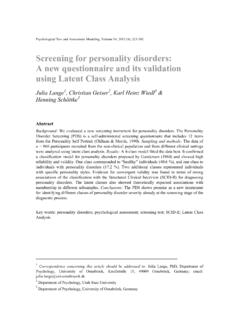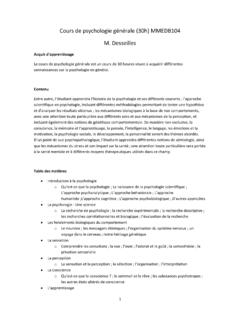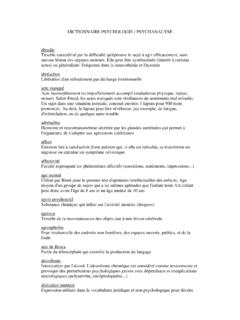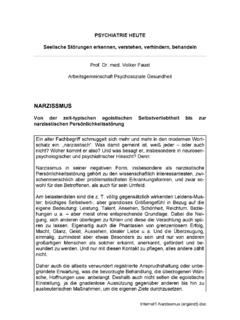Transcription of Cyberbullying in Germany – an exploration of …
1 Psychology Science Quarterly, Volume 51, 2009 (3), pp. 298-314 Cyberbullying in Germany an exploration of prevalence , overlapping with real life bullying and coping strategies JULIA RIEBEL1, REINHOLD S. J GER2 & UWE C. FISCHER2 Abstract A new phenomenon of violence among pupils has been spreading over Europe in the last few years: Cyberbullying , the repeated and intended hurting of weaker schoolmates via modern communi-cation technologies. This study shows (based on a sample of 1987 pupils), that Cyberbullying exists in Germany , al-though the number of incidents is still rather small.
2 It could also be shown, that the pupils who act as cyberbullies are the same as those who bully others in real life. The same overlap was found to be true for the victims. Cyberbullying can therefore be considered a subcategory of ordinary bullying instead of being considered a whole new phenomenon. The exploration of coping strategies showed, that a com-mon factor structure underlies physical, verbal and Cyberbullying . Considering the fact that the findings of the study are based on an online questionnaire with restricted representativeness, the results should however be interpreted carefully.
3 Key words: bullying; Cyberbullying ; coping strategies 1 Correspondence should be addressed to: Julia Riebel, PhD, Zentrum f r empirische paedagogische For-schung, Buergerstra e 23, 76829 Landau, Germany ; email: 2 Zentrum f r empirische paedagogische Forschung, Landau, Germany Cyberbullying in Germany 299 Introduction Research on school bullying and violence has a tradition of about thirty years (Smith & Brain, 2000). Since Olweus groundbreaking work in the 80ies (Olweus, 1993), a lot of knowledge has been gained about development, forms, gender and age differences, conse-quences and other features of bullying (Petermann, 2003).
4 To distinguish bullying from other acts of aggression and violence, four key criteria have to be fulfilled: There has to be the intention to hurt the victim in any kind of physical, psychological or social aspect. The aspect of repetition: We only speak of bullying, when those hurtful actions happen repeatedly and over a longer period of time. There has to be an imbalance of power, meaning that the bully is physically, mentally or socially stronger than the victim. This causes the victims to be (or at least feel) unable to defend themselves. A consequence of this is a form of helplessness of the victim, who feels defenceless and doesn t see or even try to find a way to escape the situation (Olweus, 1993; Smith & Brain, 2000).
5 Traditionally, bullying involves such acts as harassing someone verbally, physical bully-ing (beating, punching, kicking etc.), teasing, excluding someone from social activities, and threats of harm (Seals & Young, 2004). Usually, those actions are polled on three different scales, one for physical, one for verbal and one for relational bullying (Olweus, 1993; Pe-termann, 2003). Little et al. (2003) go a step further and distinguish between two dimen-sions: the whats (overt and relational aggression) in contrast to the whys (instrumental and reactive aggression).
6 However, for some years a new type of bullying has been spreading over wide parts of Europe, and has also been reported in the United States (for a discussion of this phenomenon see Ortega, Mora-Merch n & J ger, 2007). As the internet and other new media have begun to play an increasingly important role in children s and adolescents everyday life, informa-tion and communication technologies are also abused as an instrument for bullying and har-assing others. In this case we speak of Cyberbullying . The exact definition of Cyberbullying is (according to Smith et al., 2008) negative or hurtful repetitive behaviour, by the means of electronic communication tools, which involve an imbalance of power with the less-powerful person or group being unfairly attacked ( ).
7 Of course, there are several subtypes of Cyberbullying . Because Cyberbullying is a rather new phenomenon, a consensus has not yet been reached on how to categorize it. Some au-thors ( Smith, 2008) classify by type of medium, they distinguish between cyberbul-lying via SMS, via e-mail, via instant messenging and so on. However, considering the in-creasing overlap between those technologies Ortega, Mora-Merch n and J ger (2007) rec-ommend the categorization by type of action, such as the taxonomy by Willard (2006). Willard defines eight subcategories of Cyberbullying .
8 Nevertheless, not all of them can really be considered Cyberbullying if one keeps in mind, that bullying always demands the aspect of repetition. Willard herself acknowledges that fact by pointing out, that some of the phe-nomena she lists should rather be called online social cruelty . The strict definition of cy-berbullying only applies to four of Willard s subtypes (see also Riebel, 2008). J. Riebel, R. S. J ger & Uwe C. Fischer 300 Harassment can be defined as repetitiously sending insulting or threatening messages to another person by e-mail, SMS, instant messaging or in chatrooms.
9 Denigration is the spreading of rumours via electronic communication devices. Unlike with gossip in real life, by means of the internet, information can be sent to thousands of people within seconds. Outing & trickery is similar: a message revealing personal information, which the victim sent to someone in confidence, is forwarded to other people in order to compromise the victim. Exclusion is equivalent to exclusion in real life and means withholding the opportunity of taking part in social activities. In an online context this could be excluding someone from multiplayer games, chats, or platforms.
10 One might argue that denigration as well as outing and trickery are not to be considered as bullying if such incidents happen only once. Still, it should be kept in mind, that such actions include the aspect of repetition per se. Whenever a further classmate receives the hurtful message, the victim is ridiculed anew (Ortega et al., 2007). Some research has been conducted on cyberbulling so far, including Li (2006), Beran and Li (2005) as well as Kowalski et al. (2005) and Patchin and Hinduja (2006) in the United States; Slonje and Smith (2008) in Sweden and Smith et al.








